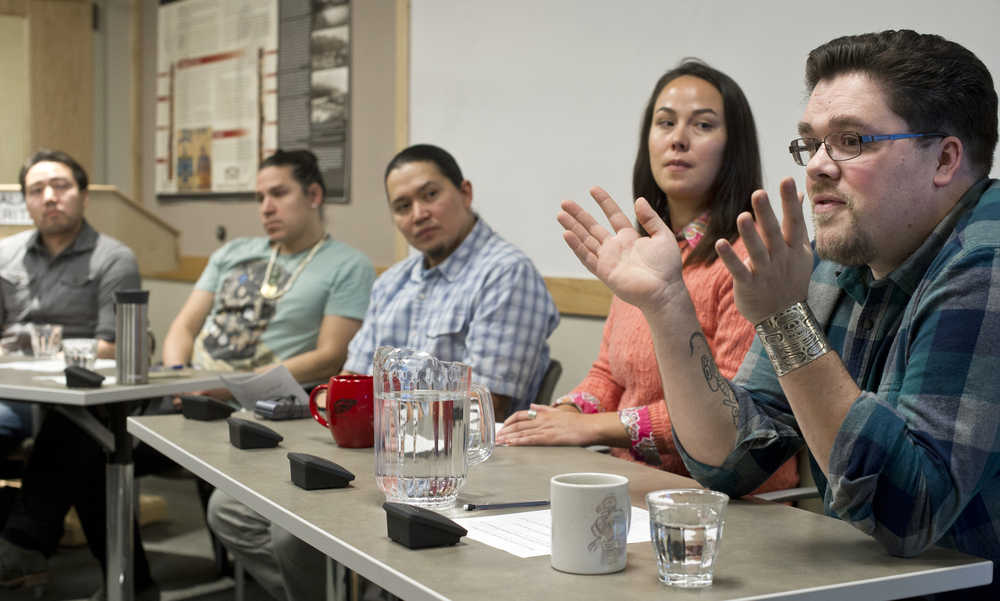At a panel on the future of Northwest Coast indigenous art, young Alaska Native artists talked about issues facing the art and the artists who make it, as well as how they’d like to see that art develop.
Panelists were Rico Worl of Juneau, Nick Galanin of Sitka, Alison Bremner of Yakutat and David R. Boxley of Metlakatla. Xhunei Lance Twitchell, an artist and assistant professor of Alaska Native Languages at the University of Alaska Southeast, moderated.
Though panelists discussed a range of issues, one theme the artists repeatedly came back to was the interconnectedness of Alaska Native art, culture and language.
“We say that our art isn’t just art; it’s a visual link to our culture,” Bremner said. “I agree with that. And… our language is the sound of our culture.”
“One thing I always tell visitors to my shop is it’s an art form that developed over thousands of years,” said Worl, co-owner of Trickster Gallery. “We’ve put a lot into it. We’ve really built it up into something spectacular.”
Panelists spoke of the crucial importance of studying the work of traditional master artists — and of a current tendency to use that term too loosely.
“Those are the best teachers,” Boxley said of the older pieces in museums. “They’re the guys that invented the system, the ones that made it work.”
“Our ancestors set the bar so high,” Bremner said. “I think we have a ways to go before we do have a widespread mastery.”
Boxley, 34, said he is sometimes called a master artist, and expressed misgivings about the label.
“Everyone’s a lifetime student,” Boxley said. “There are very few people who should receive that title of master.”
Trauma from colonization is now a part of the art, the panelists said — sometimes because artists explore it directly; sometimes because the links between masters and students were broken when European Americans and Russians bought or stole the art, and when Western diseases decimated indigenous communities.
While there are increasing numbers of Alaska Native artists, Boxley referenced his father, David A. Boxley’s, talk earlier in the lecture series, in which his father said not all that’s Native-made is good.
“I thought ‘Wow, he’s brave (to say that),’” Boxley said. “It’s the truth, and it’s true of any art form.”
Formline, Boxley said, is “a very misunderstood system of art, even by our own people. Formline is as complicated as any other thing you can think of — it’s not just a bunch of shapes thrown together. It works best when the guidelines are followed, because it is a system. You can only learn that by starting from the ground up.”
“Our art wasn’t art in the Western sense,” Boxley said. “It wasn’t just pretty to hang on a wall.”
Much Northwest Coast art today is that way, he said, including some of his pieces — something he struggles with and reconciles by using the time it frees up to do his part revitalizing Tsimshian culture in Metlakatla.
Other issues, the artists added, are appropriation, access to pieces created pre-colonization, the European-American systems they find themselves having to navigate, white privilege, and equal appreciation for Alaska Native female and male artists.
Opportunity, Galanin said, is “always an issue.” So is funding, for all art; and so is having indigenous art represented in the rest of the art world.
Galanin, though he noted positive development, said higher education has room to improve.
“Generally speaking, you have to hang up your identity to go through these institutions to get an idea of success,” he said.
“That’s one we can always come back to,” Worl said of appropriation, in which people who are not of a (usually minority) culture use elements of it to benefit financially. “I think a lot of people in the world appreciate authentic things… but I think a lot of people just kind of let it slide, as well.”
Women should also receive more widespread recognition and support, they said.
“Alison and my sister (Crystal Worl) are both working on representing women in Northwest coastal art… I think you see less women in galleries, and that’s something that should be remedied,” Worl said.
“I hope weaving and basketry starts to get its due like carving does,” Boxley said. “I think it’s harder for women, because the process is longer to gather those materials… but it’s just as beautiful and worthy of (a gallery) as anything a man makes. Or man weaving, or a woman carving.”
As a female carver (carving is traditionally a male pursuit) Bremner encouraged women, especially female artists, to find partners who will help shoulder domestic duties.
Just as who can create certain kinds of art is different in the modern world, so are the tools people use to create that art.
Regardless of the medium or the tools people use, or the level to which it is innovative or new (Boxley created a formline Superman “S”; Worl creates formline skateboards) what’s important is that the work is quality, the panelists said.
At the end of the panel, elder and carver Paul Marks spoke on art and at.oow, sacred objects. “Our art, our at.oow… what we do with our hands is more valuable than money,” Marks said. “Your best art pieces come when you take time to do it.”
“It’s part of us,” Xhunei commented. “When the at.oow comes out, you see your ancestors right there in front of you.”
“We’re competing with the modern world while living in the modern world, building an identity as contemporary Native people while at the same time recovering from that trauma,” Boxley said. “It’s a very peculiar time to be doing what we’re doing… it’s a challenge I think we’re all up for.”
• Contact Capital City Weekly staff writer Mary Catharine Martin at maryc.martin@capweek.com.

